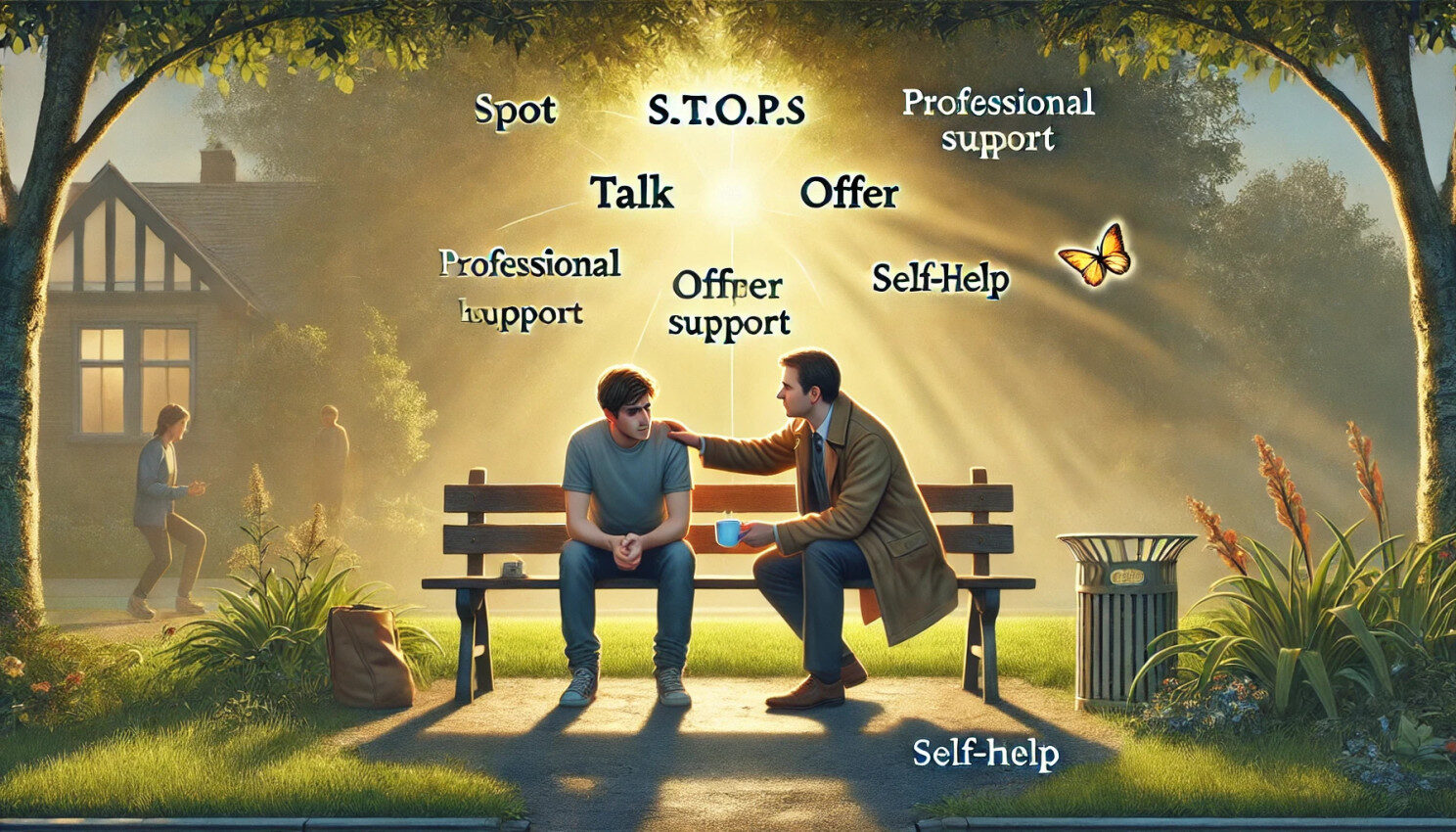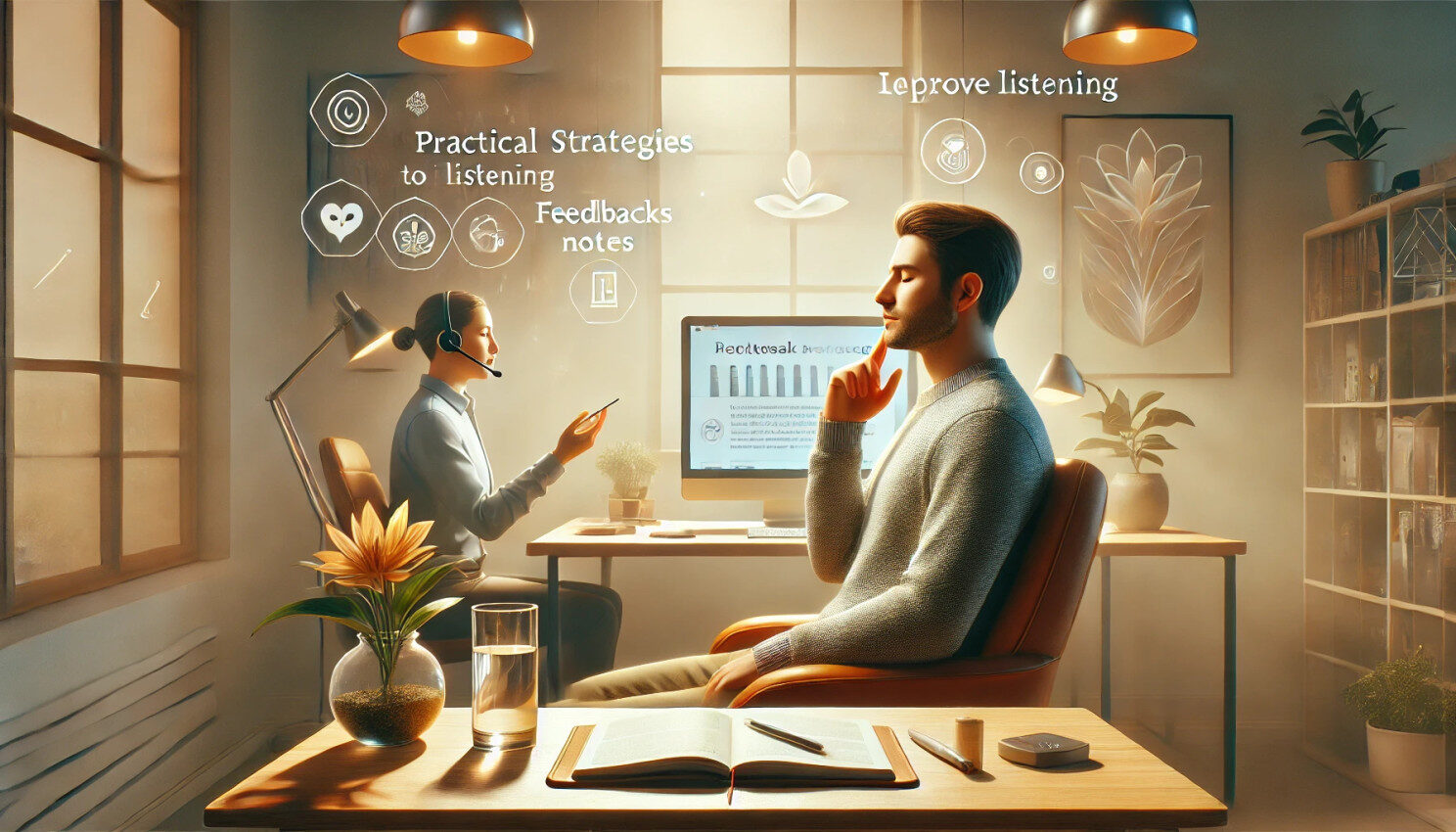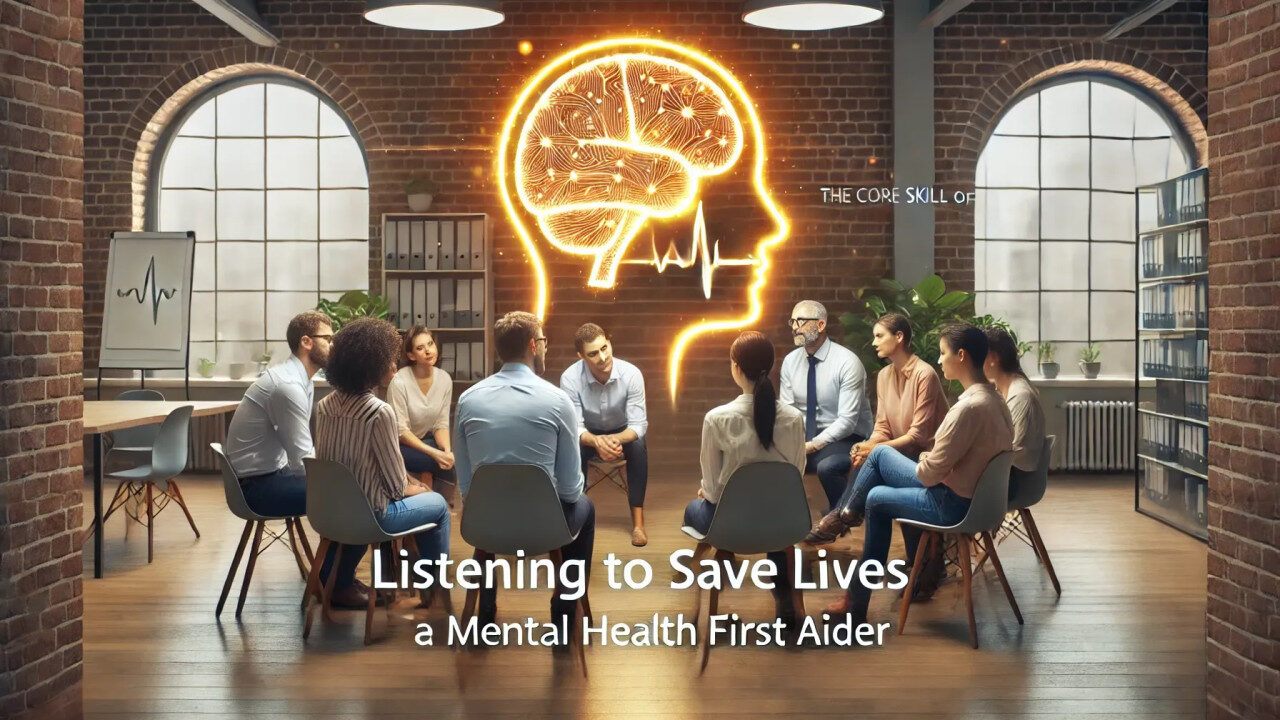Listening is the cornerstone of mental health first aid. It is the act of creating a safe, empathetic space where individuals feel valued, understood, and heard. For Mental Health First Aiders (MHFAs), listening is not just a skill, it is a lifeline. By truly listening, we open the door for individuals to express their struggles, often for the first time, and begin their journey toward healing.
Table of Contents
- The Power of Listening
- The Science Behind Listening – Why It Is Transformative
- Key Principles of Active Listening for Mental Health First Aiders
- The S.T.O.P.S. Framework: Breaking it Down for Understanding
- Overcoming Barriers to Effective Listening
- Listening in Hybrid and Remote Workplaces
- The Ripple Effect – How Listening Shapes Workplace Culture
- Conclusion – Listening is a Lifeline
The Power of Listening
Imagine a situation where someone is overwhelmed and dragged down by life’s challenges, be it stress related, anxiety, depression, grief, or another mental health concern. In such moments, the opportunity to speak openly without fear of judgement can feel like a lifeline. Listening provides a critical first step in breaking the silence that often surrounds mental health issues, enabling individuals to recognise their feelings and take actionable steps toward recovery.
Listening Saves Lives
- In serious critical situations, listening can slow down distress, reduce feelings of isolation, and help individuals feel connected and supported.
- Numerous studies show that individuals contemplating suicide often reconsider when they feel genuinely heard and valued.
Listening as a Stigma-Breaker
Mental health stigma thrives in environments where people feel ignored or judged. Listening combats this by fostering openness and trust. When someone feels listened to:
- They are more likely to seek help and share their experiences.
- The fear of being judged diminishes, making conversations about mental health more accessible and less intimidating.
Personal Reflection
For me, listening was a skill I thought I understood until I completed my Mental Health First Aid training. I realised that listening goes far beyond simply hearing words; it involves being present, empathetic, and non-judgemental. My training taught me how powerful listening can be, not just in supporting others but in encouraging them to trust and take the first steps toward recovery.
Listening is a Lifeline
Listening is not just an interpersonal skill, it is an act of advocacy. It demonstrates care, compassion, and commitment to supporting others. As I delve into this post, we will explore the science, techniques, and challenges of listening, equipping you with the tools to be a more effective listener both as an MHFA and in everyday life.
The Science Behind Listening – Why It Is Transformative
Listening is more than just an exchange of words; it is a profound psychological act that can transform relationships, reduce stress, and encourage healing. Scientific research underscores the critical role listening plays in mental health support, making it the most essential tool in a Mental Health First Aider’s (MHFA) arsenal.
The Psychology of Being Heard
- Validation and Emotional Relief: When individuals feel listened to, they experience a sense of validation, an acknowledgment of their emotions and experiences. This validation reduces feelings of isolation and can offer immense emotional relief, particularly for those struggling with anxiety, depression, or stress.
- The Human Need for Connection: Listening fulfils a fundamental human need for connection. According to psychologist Carl Rogers, genuine listening fosters self-worth and confidence, allowing individuals to feel valued and understood.
- Neurochemical Impact: Studies have shown that empathetic listening can reduce cortisol levels (the stress hormone) and increase oxytocin, often referred to as the “bonding hormone.” This physiological response fosters trust and calms the nervous system.
How Listening Promotes Healing
Listening provides individuals with a safe space to process their thoughts and emotions. Often, people struggling with mental health challenges find it difficult to articulate their feelings, leading to frustration and hopelessness. Active listening:
- Encourages individuals to explore and express their emotions.
- Creates clarity, helping them understand their struggles and identify potential solutions.
- Reduces the mental “weight” of unspoken worries or stress, offering a path toward relief.
The Role of Silence in Listening
Sometimes, silence speaks louder than words. Pausing to let someone gather their thoughts or reflect on what they are sharing demonstrates patience and respect. Silence:
- Provides individuals with the time and space to fully express themselves without feeling rushed.
- Reinforces the listener’s presence and attentiveness.
The Ripple Effect of Listening

Listening has a ripple effect that extends beyond the individual. When someone feels supported, they are more likely to:
- Share their positive experience with others, encouraging them to seek support as well.
- Take proactive steps to improve their mental health and well-being.
- Foster a culture of openness and empathy within their personal and professional circles.
Scientific Backing
A 2021 study published in the Journal of Positive Psychology revealed that individuals who received active listening during a conversation reported a 30% reduction in perceived stress levels compared to those who did not. This underscores the critical role listening plays in mental health support, particularly in critical situations.
Listening Beyond Hearing – Inclusivity in the Role of a Listener
While listening is often thought of as hearing, it is much more than auditory perception. For those with hearing impairments or other disabilities, listening becomes a deeply intentional act that goes above and beyond sound and focuses on connection, empathy, and understanding.
Listening Through Different Approaches
- Visual Cues: People with hearing loss often rely on facial expressions, body language, and lip-reading to interpret emotions and intentions. This heightened visual awareness can sometimes make them more attuned to subtle non-verbal cues others might overlook.
- Written Communication: For individuals who face barriers to auditory listening, written communication, like emails, messages, or even handwritten notes, becomes a key way to “listen” and engage with someone. This alternative form of dialogue ensures that listening is inclusive and not confined to verbal exchanges.
- Assistive Technology: Tools like live transcription apps, closed captioning on video calls, and hearing aids help bridge gaps in auditory communication. Organisations should ensure accessibility by integrating these tools into meetings, training, and support sessions.
The Power of Empathy Over Sound
Listening, at its core, is about understanding, not just hearing. An individual with hearing loss may not pick up on every word, but their focus on connecting with the other person ensures that the essence of listening remains intact. This redefines listening as a process of presence and empathy rather than a purely auditory act.
Example:
A colleague who is deaf might use sign language, written notes, or an interpreter to engage in a deep and meaningful conversation, proving that listening is about intention, not just the mechanics of hearing.

Creating Inclusive Spaces for Listening
For organisations and teams, creating environments where everyone, regardless of ability, can listen and feel listened to is crucial. Here are some steps to foster inclusivity:
- Train Teams on Accessible Communication: Teach employees about non-verbal listening, written communication, and assistive technology. Raise awareness about the importance of inclusivity in mental health conversations.
- Use Inclusive Meeting Practices: Ensure all meetings and conversations are accessible through captions, transcripts, or sign language interpreters. Encourage a culture where individuals feel comfortable asking for accommodations.
- Recognise Diverse Strengths in Listening: Acknowledge that individuals with hearing impairments often bring unique strengths to listening, such as heightened emotional awareness or visual observation skills.
Does your organisation understand accessibility? offer sign-language for those with hearing loss? Food for thought in the inclusive landscape we all work and live in.
The Effect of Inclusive Listening
When we adapt listening to include everyone, the ripple effect becomes even more profound:
- For the Listener: They feel empowered and valued, knowing their role in fostering connection is not diminished by their disability.
- For the Speaker: They see that their voice matters, regardless of the medium of communication.
- For the Organisation: Inclusive listening practices build trust, enhance collaboration, and strengthen the bonds within diverse teams.
My Personal Perspective
Reflecting on my journey, I now realise how often I overlooked the power of listening before becoming an MHFA. Whether it was during moments of grief, stress, or personal challenges, the simple act of someone genuinely listening to me made an immeasurable difference. This training has reinforced my belief that listening is not just a skill, it is a responsibility. Listening is not a passive act; it is an intentional, transformative tool that has the power to save lives. In the next section, we will explore practical techniques for mastering active listening, equipping you to provide meaningful support as a Mental Health First Aider or advocate.
Key Principles of Active Listening for Mental Health First Aiders

Active listening is a skill that goes beyond simply hearing words, it is about fully engaging with the speaker, understanding their emotions, and providing a supportive, judgment-free environment. For Mental Health First Aiders (MHFAs), mastering active listening is essential to creating a safe space where individuals feel heard and valued.
What is Active Listening?
Active listening involves focusing entirely on the speaker, both verbally and non-verbally, to understand not only what they are saying but also how they are feeling. It is a collaborative process that fosters trust, openness, and connection.
Core Principles of Active Listening
Be Fully Present
- What it Means: Give your undivided attention to the speaker, free from distractions like phones, emails, or external noise.
- Why it Matters: Being fully present shows the individual that their concerns are important and valued.
Tip: In remote or hybrid settings, ensure you are in a quiet, private space and use non-verbal cues, such as nodding, to show engagement during video calls.
Practice Empathy
- What it Means: Try to understand the speaker’s feelings and perspectives without imposing your own judgments or assumptions.
- Why it Matters: Empathy helps build trust and encourages the individual to share openly.
Tip: Use phrases like, “That sounds really difficult,” or, “I can see why you’re feeling that way,” to validate their emotions.
Use Open-Ended Questions
- What it Means: Encourage the speaker to elaborate on their feelings or experiences by asking questions that cannot be answered with a simple “yes” or “no.”
- Why it Matters: Open-ended questions help individuals reflect and express themselves more freely.
Examples:
- “Can you tell me more about how you’re feeling?”
- “What has been the most challenging part of this for you?”
Reflect and Paraphrase
- What it Means: Repeat or summarise what the speaker has said to show that you understand and are actively engaged.
- Why it Matters: Reflection demonstrates attentiveness and helps clarify any misunderstandings.
Respect Silence
- What it Means: Allow pauses during the conversation, giving the speaker time to gather their thoughts or emotions.
- Why it Matters: Silence can be powerful, providing space for reflection and deeper sharing.
Tip: Resist the urge to fill every silence with words; sometimes, just being there is enough.
Avoid Judgement and Advice-Giving
- What it Means: Focus on listening and understanding rather than trying to “fix” the problem or offer unsolicited advice.
- Why it Matters: Judgements or premature solutions can discourage the speaker from sharing and may make them feel invalidated.
Tip: If advice is sought, guide the individual toward professional resources or self-help strategies instead of prescribing solutions.
The S.T.O.P.S. Framework: Breaking it Down for Understanding
The S.T.O.P.S. Framework is an easy-to-remember approach that Mental Health First Aiders (MHFAs) use to guide conversations with someone who may be struggling. It is about being observant, compassionate, and offering meaningful support. Let us break it down into simple terms:

S = Spot Signs of Distress
Think about when you see a friend or family member acting differently, maybe they seem quieter than usual, stop joining in activities, or even get upset over things that usually would not bother them. These are signs that something might be wrong.
- What You Can Do: Pay attention to changes in behaviour, body language, or mood.
- Why It Matters: Spotting these signs early gives you the chance to help before things get worse.
T = Talk
Talking is the next step. Imagine you notice your friend looks upset at school or home, and you want to help. You do not need to be an expert; just letting them know you are there for them can make a big difference.
- What You Can Do: Start by saying what you have noticed, using kind and open words.
- Why It Matters: Sometimes, people just need a little encouragement to open up. When you invite them to talk, you show that you care and are ready to listen.
O = Offer Care, Hope, and Comfort
Imagine how you feel when someone gives you a hug, a kind word, or reassures you that things will be okay. Offering care and comfort is about doing the same for others.
- What You Can Do: Say things like, “I’m here for you,” or “You’re not alone in this.”
- Let them know that what they are feeling is okay, and it is normal to struggle sometimes.
- Avoid saying things like, “Just get over it” or “It’s not a big deal,” because that can make someone feel worse.
- Why It Matters: When people feel cared for, they are more likely to share and trust you to help them find support.
P = Professional/Organisational Support
Sometimes, problems are too big to handle alone, and that is okay. The most important part of helping someone is knowing when to guide them to someone who can help professionally.
- What You Can Do: Suggest that they talk to a trusted adult (a teacher, parent, or coach) or seek help from a counsellor, therapist, or doctor. If you’re at work, point them to resources like an Employee Assistance Programme (EAP) or a mental health helpline.
- Why It Matters: Professionals are trained to help people with bigger challenges, and connecting someone with the right support can make all the difference.
S = Self-Help and Other Strategies
When things feel tough, there are small things we can all do to take care of ourselves. These self-help strategies may not solve everything, but they can help someone feel a little better.
- What You Can Do: Suggest simple activities like Going for a walk or doing some light exercise, writing down feelings in a journal, Taking a few deep breaths or trying mindfulness exercises.
- Suggest they spend time with friends or doing something they enjoy.
- Why It Matters: Sometimes, just starting with a small, positive action can create a ripple effect that helps someone feel more in control and hopeful.
Becoming a Lifeline
Active listening is not about having the perfect response, it is about creating a safe, supportive space where someone feels empowered to share and seek help. By mastering these techniques, MHFAs can provide meaningful support that has the potential to change lives.
Overcoming Barriers to Effective Listening
Even with the best intentions, listening can be challenging. Life is full of distractions, personal biases, and emotional barriers that can prevent us from truly hearing and understanding someone in need. For Mental Health First Aiders (MHFAs), overcoming these obstacles is crucial to offering meaningful support.
Common Barriers to Listening
Distractions and Multitasking
- What Happens: You might be physically present but mentally preoccupied with work, notifications, or other responsibilities.
- How to Overcome: Set aside distractions, put your phone on silent, close unnecessary tabs, and dedicate your full attention to the conversation.
Personal Biases and Assumptions
- What Happens: Without realising it, you might judge someone’s feelings or assume you know what they need.
- Impact: Biases can lead to invalidating someone’s experience, discouraging them from opening up further.
- How to Overcome: Approach every conversation with curiosity and without judgement. Remind yourself that everyone’s experiences and emotions are valid, even if they differ from your own.
The Need to “Fix” the Problem
- What Happens: It is natural to want to solve someone’s problem, but jumping in with solutions too quickly can make the person feel dismissed.
- How to Overcome: Focus on listening rather than solving. Use affirming statements like, “That sounds really hard,” or, “I’m here to listen if you need to talk.” Encourage the individual to explore their own thoughts and solutions.
Emotional Fatigue
- What Happens: Supporting others can be emotionally taxing, especially if you’re feeling overwhelmed yourself.
- How to Overcome: Recognise your limits and practice self-care. Remember, you can only support others effectively if you are taking care of your own well-being.
Practical Strategies to Improve Listening
- Practice Mindfulness: Mindfulness exercises can help you stay present during conversations. Simple techniques like deep breathing or focusing on the speaker’s words can reduce mental clutter.
- Acknowledge Your Limitations: It is okay to admit when you do not have all the answers. Instead, focus on guiding the person toward resources or professionals who can provide further help.
- Ask for Feedback: After a conversation, ask the person if they felt supported. This can help you refine your listening skills and better meet their needs in the future.
- Take Breaks When Needed: Supporting multiple people or dealing with emotionally intense situations can lead to burnout. Taking a step back to recharge is not a weakness—it is a necessary part of being a compassionate listener.

When you address these barriers, you become a better listener, building trust and creating an environment where the individual feels safe to share. Overcoming these challenges also reinforces the skills and confidence needed to support someone effectively, whether in a workplace, hybrid, or remote environment.
Listening in Hybrid and Remote Workplaces
As workplaces evolve, with hybrid and remote working becoming the norm, the art of listening must adapt to meet new challenges. Mental Health First Aiders (MHFAs) play a critical role in supporting colleagues across physical and digital spaces, ensuring that everyone feels heard and valued, no matter where they are.
The Challenges of Remote Listening
Listening in a remote or hybrid environment comes with its own set of obstacles:
- In virtual settings, body language, facial expressions, and other non-verbal cues are harder to spot.
- Subtle signs of distress, such as slumped posture or tearfulness, may not be visible on a video call, especially if someone has their camera off.
- Poor internet connections, lagging video, or muted microphones can disrupt the flow of conversation.
- A lack of privacy during calls may make individuals hesitant to open up.
Digital Fatigue
Remote work often leads to “Zoom fatigue,” where prolonged screen time reduces focus and empathy, making meaningful listening harder.
Isolation and Disconnect
- Remote employees may feel more isolated, making them less likely to reach out for help.
- The absence of casual in-office interactions can delay early recognition of mental health concerns.
Adapting Listening Skills for Virtual Settings
Scenario: A remote employee sends an email saying they are struggling with their workload.
- Step 1 – Spot Signs of Distress: Recognise that their email is an indirect way of seeking help.
- Step 2 – Talk: Set up a private video or voice call to discuss their concerns.
- Step 3 – Offer Care: Use empathetic language, such as, “I’m here to help. It’s okay to feel overwhelmed, it happens to all of us.”
- Step 4 – Guide Them: Suggest steps like speaking to their manager about workload adjustments or accessing organisational support resources.
- Step 5 – Follow Up: Check in a few days later to see how they are feeling and whether the situation has improved.
Listening Beyond Words
Remote listening often requires paying attention to what is not being said. For instance:
- Do they respond to emails or messages less frequently than usual?
- Are they avoiding team meetings or contributing less during calls?
- Do their written communications seem shorter, more abrupt, or lacking their usual tone?
By noticing these subtle changes, MHFAs can initiate supportive conversations that might not otherwise happen.
Fostering Inclusion in Hybrid Teams
In a hybrid workplace, it is crucial to ensure that remote employees are not left out of conversations. Encourage equal participation by:
- Actively inviting input from remote team members during meetings.
- Offering multiple ways for employees to reach out, such as messaging apps, emails, or scheduled calls.
- Building a culture where mental health conversations are seen as a shared responsibility, whether in person or online.
The Future of Listening in Digital Workplaces

As technology advances, new tools such as AI-driven sentiment analysis or wellness apps may enhance remote listening. However, no technology can replace the human connection and empathy that come from truly listening. By adapting traditional listening skills to modern workplaces, MHFAs can ensure that support is accessible and effective for everyone, regardless of location.
The Ripple Effect – How Listening Shapes Workplace Culture
Listening is not just an individual skill; it is a transformative force that can reshape workplace culture. When organisations prioritise listening, they create environments where mental health and well-being are at the forefront, fostering trust, collaboration, and resilience. This ripple effect extends beyond individual interactions, influencing teams, leaders, and the organisation as a whole.
The Power of a Listening Culture
- Normalising Mental Health Conversations: When employees see that their voices are heard, they are more likely to share their experiences without fear of judgement or stigma. Mental health becomes part of everyday conversations, rather than a taboo or afterthought.
- Strengthening Trust and Collaboration: Teams that practice active listening develop deeper trust and understanding, leading to stronger relationships and more effective collaboration. Employees feel valued, which enhances morale and productivity.
- Enhancing Employee Engagement: Workers who feel heard are more engaged, motivated, and committed to their organisation’s goals. According to a Gallup report, employees are 4.6 times more likely to perform their best work when they feel their voice is heard.
- Driving Organisational Success:A listening culture contributes to reduced absenteeism, increased retention, and higher job satisfaction all of which positively impact the bottom line. Organisations with strong listening practices are viewed as ethical and progressive, attracting top talent.
How Listening Ripples Across Teams
- Leaders Setting the Tone: Leaders who model active listening encourage their teams to do the same. Their behaviour sends a clear message: every voice matters.
- Colleagues Supporting Each Other:When peers listen to one another, they build a sense of community and mutual support.
- Creating Inclusive Workspaces: Listening ensures that diverse perspectives are heard and valued, fostering inclusivity and innovation. Teams with a variety of voices thrive when everyone feels they have an equal opportunity to contribute.
Practical Steps to Embed Listening in Workplace Culture
- Train Employees in Active Listening: Offer workshops or seminars to teach active listening techniques, ensuring employees at all levels can engage meaningfully.
- Encourage Open Dialogue: Create regular opportunities for employees to share feedback, such as “town halls”, anonymous surveys, or one-on-one meetings.
- Recognise and Reward Listening: Celebrate individuals or teams that demonstrate strong listening practices, reinforcing its value within the organisation.
- Lead by Example:Leadership teams should actively practice and promote listening as a core organisational value.
The Ripple Beyond Workplaces
The impact of listening does not stop at the office door. When individuals feel supported at work, they carry those positive effects into their personal lives, improving relationships with family, friends, and communities. The ripple effect of a listening culture extends far and wide, shaping a more empathetic and understanding society. Every workplace has the potential to become a hub of care and connection. By fostering a culture of listening, organisations can create environments where individuals feel empowered to share, thrive, and contribute their best.
Conclusion – Listening is a Lifeline
Listening is more than just a skill, it is an act of profound connection that can transform lives and workplaces. In a world where many feel unseen, unheard, or misunderstood, the simple act of listening becomes a lifeline. It is a reminder that we are not alone in our struggles, and it creates an opportunity for healing, understanding, and hope.

For Mental Health First Aiders (MHFAs), listening is the foundation of their role. It is the first step in recognising distress, validating emotions, and guiding individuals toward the help they need. But the power of listening extends beyond individuals; it ripples outward, shaping the dynamics of teams, strengthening organisational culture, and fostering a society where mental health is prioritised.
In the increasingly digital world, where hybrid and remote work can make human connection feel distant, listening has never been more important. It bridges gaps created by physical distance, breaks down barriers of stigma, and encourages meaningful dialogue about mental health. By truly listening, we create environments where people feel valued, respected, and supported, a culture of care that benefits everyone.
Key Takeaways
- The Transformative Power of Listening: Listening is the first step toward breaking the silence that often surrounds mental health issues. It empowers individuals to share their struggles, take action, and begin their journey to recovery.
- Active Listening is a Skill Anyone Can Master: Techniques like maintaining focus, practicing empathy, and using the S.T.O.P.S. Framework ensure conversations are meaningful and supportive. Even small efforts to listen better can have a significant impact on someone’s mental well-being.
- Overcoming Barriers is Essential: By recognising and addressing distractions, biases, and emotional fatigue, we can become more effective listeners. Remote and hybrid environments require adapting traditional listening skills to ensure inclusivity and connection.
- Listening Shapes Workplace Culture: A culture of listening reduces stigma, strengthens trust, and boosts engagement, leading to happier, healthier, and more productive workplaces. Leaders who model active listening set the tone for organisational success.
- Listening Saves Lives: Whether it is supporting a friend in crisis, a colleague facing burnout, or a remote employee feeling isolated, listening can be the difference between struggle and hope.
My Personal Reflection – What have I learned?
For much of my life, I thought of listening as something we all did naturally. But through my journey to a Mental Health First Aider, I have come to understand how intentional, active listening can be life-changing.
Reflecting on my experiences, I now see how much of an impact listening has had on my own mental health. During moments of personal challenge, whether dealing with grief, burnout, or health crises, the simple act of someone listening to me without judgement made a world of difference. It was not about them offering solutions but about them being there, fully present, and giving me the space to share my feelings – their is one person I will owe more than life to – and she knows who she is!
Becoming a qualified Mental Health First Aider has deepened my appreciation for the power of listening. I have seen how a single conversation can break the silence that holds people back, how it can inspire hope, and how it can guide someone toward the help they need. Listening is not just a tool, it is a gift, one we can all give and receive no matter if you are hard of hearing, inclusivity is as important as listening.
This journey has taught me that listening is not always easy. It requires patience, empathy, and self-awareness. But the rewards, for the person being heard and the person offering their ear, are immeasurable. I no longer take listening for granted. Instead, I see it as a responsibility, a privilege, and a cornerstone of how we can support one another in times of need.
A Call to Action
Listening is not something we do out of obligation, it is something we do out of care. It is a skill that requires practice, patience, and intentionality, but the impact it has is profound. By committing to listen more deeply, more compassionately, and more intentionally, we can create a ripple effect of understanding and support.
As I conclude this post, I encourage you to reflect on your own listening practices:
- When was the last time you truly listened to someone?
- How can you create spaces where others feel safe to share?
- What steps will you take to deepen your listening skills and foster a culture of care in your workplace and community?
Listening is more than hearing words, it is about understanding, validating, and connecting. We can make listening a cornerstone of a world where mental health and well-being are valued and prioritised. We just have to take one step at a time and learn from the journey.

This post concludes part 1 of my Mental Health series – next up is Part 2 where i delve deep into some emotional and difficult information – “Understand specific mental health challenges, including stress, suicide, and various disorders” – I hope these post achieve my overall aim for this series, to bring knowledge, understanding and information to the front. Remember – Mental Health affects everyone, every day and it is up to each of us to understand the trying, struggles and Illnesses that it can cause and affect.
Next in the Series: “Stress: The Silent Productivity Killer”
In my next post, we will explore the pervasive issue of stress and its impact on mental health and productivity. We will uncover how to recognise the signs of stress, understand its effects on individuals and organisations, and implement strategies to manage it effectively. Join me as I take the next step in this journey toward mental health awareness, well-being, and resilience.
Thanks for reading and joining me on this journey.

















